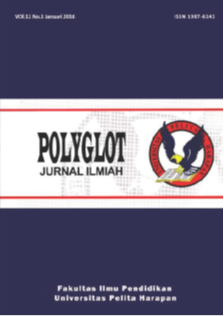The Effect of Brainstorming Implementation on Students’ Engagement in Learning about Probability in Math Classes in Grade XI IPA at SMA ABC Cikarang
DOI:
https://doi.org/10.19166/pji.v1i1.380Λέξεις-κλειδιά:
brainstorming, student engagement, probability, penerapan, keterlibatan siswa, probabilitasΠερίληψη
This research aims to determine the effects of brainstorming on students’ engagement in learning about probability. The method used in this research is the quasi-experimental with a non-equivalent control group. The sampling technique is in the form of a census. The data was collected through a questionnaire and analyzed by using non-parametric tests -- the Mann-Whitney U-test and the Wilcoxon Signed-Rank test with alpha level of 0.05. The results show that: 1) there was no significant difference on students’ engagement before and after the experiment in the group that was taught without brainstorming; 2) there was significant difference on students’ engagement before and after the experiment in the group taught with brainstorming; and 3) there was no significant difference on students’ engagement between the group that was taught with brainstorming and the group that was taught without brainstorming. The result of this research indicates that implementing brainstorming produces a positive effect on students’ engagement in learning about probability in math classes in grade XI IPA at SMA ABC Cikarang.
BAHASA INDONESIA ABSTRAK: Penelitian ini bertujuan untuk menemukan pengaruh penerapan brainstorming terhadap keterlibatan siswa dalam mempelajari topik peluang.Metode yang digunakan dalam penelitian ini adalah quasi-eksperimen dengan desain non-equivalent control group. Data dikumpulkan melalui kuisioner dan dianalisis dengan uji non-parametrik, yaitu uji Mann-Whitney U dan uji Wilcoxon Signed-Rank dengan taraf signifikansi 0.05.Hasil penelitian menunjukkan bahwa: 1) tidak ada perbedaan yang signifikan dalam keterlibatan siswa antara sebelum dan sesudah perlakuan di grup yang diajar tanpa brainstorming (hasil uji Wilcoxon Signed-Rank: ); 2) ada perbedaan yang signifikan pada keterlibatan siswa antara sebelum dan sesudah perlakuan di grup yang diajar dengan brainstorming (hasil uji Wilcoxon Signed-Rank: ); dan 3) tidak ada perbedaan yang signifikan pada keterlibatan siswa antara grup yang diajar dengan brainstorming dan tanpa brainstorming (hasil uji Mann-Whitney U: ). Hasil dari penelitian ini mengindikasikan bahwa penerapan brainstorming memberikan pengaruh yang positif terhadap keterlibatan siswa dalam mempelajari peluang di pelajaran matematika kelas XI IPA SMA ABC Cikarang.
Αναφορές
Beer, C. Clark, K., & Jones, D. (2010). Indicators of engagement.In C.H. Steel, M.J. Keppell, P. Gerbic & S. Housego (Eds.), Curriculum, technology & transformation for an unknown future. Proceedings ascilite Sydney 2010 (pp. 75-86). Retrieved from http://ascilite.org.au/conferences/sydney10/procs/Beer-full.pdf Ellis, D. (2011). From master student to master employee (3rd ed.). Belmont, CA: Cengage Learning.
Hott, B., Isbell, L., & Montani, T. O. (2014). Strategies and interventions to support students with mathematical disabilities. Overland Park, KS: Council for Learning Disabilities. Retrieved from https://www.council-for-learning-disabilities.org/wp-content/uploads/2014/12/Math_Disabilities_Support.pdf
Isaksen, S. G., Dorval, K. B., & Treffinger, D. J. (1998). Creative problem solving. Buffalo, NY: Center for Creative Learning, Inc.
Jones, G. A. (2006). The challenges of teaching probability in school. Queensland, Australia: Griffith University. Retrieved from http://www.mathunion.org/fileadmin/ICMI/files/Digital_Library/ICMEs/Bulletin_Jones.pdf
Light, G., Cox, R., & Calkins, S. (2009). Learning and teaching in higher education: the reflective professional. London: Sage Publications.
McCune, S. L., & Alexander, V. C. (2015). CliffsNotes FTCE professional education test (3rd ed.). New York: Houghton Mifflin Harcourt.
Miller, R. L. (2011). Introduction. In R. L. Miller, E. Amsel, B. M. Kowalewski, B. C. Beins, K. D. Keith, & B. F. Peden (Eds.), Promoting student engagement (Vol. 1, pp. 2-8). Retrieved from the Society for the Teaching of Psychology Web site http://teachpsych.org/ebooks/pse2011/index.php
New Zealand Ministry of Education. (2012). Factors that influence student engagement. New Zealand Curriculum Online. Retrieved from http://nzcurriculum.tki.org.nz/Middle-schooling/Engagement
Osborn, A. (2009). Unlocking your creative power. Amherst, MA: Creative Education Foundation.
Reading, C. (2007). Recognising and measuring engagement in ICT-rich learning. University of New England: SiMERR National Centre.
Riadi, E. (2014). Metode statistika parametrik dan non-parametrik. Tangerang: Pustaka Mandiri.
Santrock, J. (2011). Educational psychology (5th ed.). New York: McGraw Hill.
Skilling, K. G., Bobis, J., & Martin, A. (2015). The engagement of students with high and low achievement levels in mathematics. In K. Beswick, T. Muir, & J. Wells (Eds.), Proceedings of the 39th Psychology of Mathematics Education conference. (Vol. 4, pp. 185-192). Hobart: Australia: Psychology of Mathematics Education (PME). Retrieved from https://www.researchgate.net
Taylor, L., & Parsons, J. (2011). Improving student engagement. Current Issues in Education, 14(1), 1-33. Retrieved from http://cie.asu.edu/
Tracy, B. (2003). Change your thinking, change your life: How to unlock your full potential for success and achievement. Hoboken, NJ: Wiley.
Userfit Tools. (1996). Brainstorming. In Userfit design handbook. Retrieved from http://www.education.edean.org/pdf/Tool052.pdf
Wilson, C. (2013). Brainstorming and beyond. USA: Elsevier.
Winter, P., & Foster, M. (n.d.). Student engagement and quality pedagogy. The South Australian Curriculum Standards & Accountability Framework (SACSA), 1.
Λήψεις
Δημοσιευμένα
Τεύχος
Ενότητα
Άδεια
Authors who publish with this journal agree to the following terms:
1) Authors retain copyright and grant the journal right of first publication with the work simultaneously licensed under a Creative Commons Attribution License (CC-BY-SA 4.0) that allows others to share the work with an acknowledgement of the work's authorship and initial publication in this journal.
2) Authors are able to enter into separate, additional contractual arrangements for the non-exclusive distribution of the journal's published version of the work (e.g., post it to an institutional repository or publish it in a book), with an acknowledgement of its initial publication in this journal.
3) Authors are permitted and encouraged to post their work online (e.g., in institutional repositories or on their website). The final published PDF should be used and bibliographic details that credit the publication in this journal should be included.





